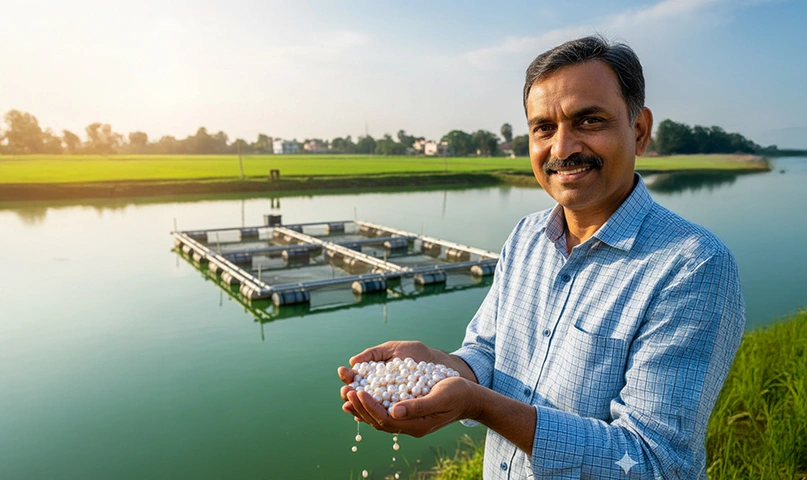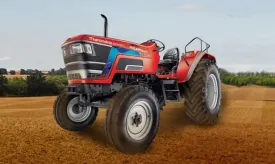Mulching in Agriculture: Benefits, Types, and How to Use It Effectively

Agriculture is not only about seeds, water, and fertilizers—it is also about how we manage the soil itself. Among the many soil management practices that have stood the test of time, mulching holds a special place. Though it may look simple—just covering the soil with a protective layer—mulching can dramatically transform crop health and productivity when done right.
By applying mulch, farmers and gardeners can unlock multiple advantages: improved soil fertility, reduced water loss, better weed control, and protection from temperature extremes. Yet the real success of mulching lies not only in applying it, but in choosing the right materials, timing, and technique. If done poorly, mulching can even create new problems.
This comprehensive guide—drawing from insights published by New Agri India’s “The Ultimate Guide to Mulching in Agriculture”—offers farmers, horticulturists, and gardening enthusiasts a step-by-step approach to understanding, selecting, and applying mulching effectively.
What Exactly Is Mulching?
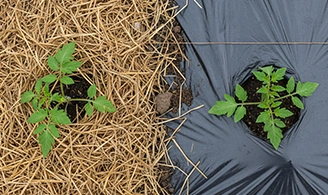
Mulching is the practice of covering the soil surface around plants with a layer of material. This material, called mulch, can be:
- Organic, such as crop residues, straw, leaves, grass clippings, or compost.
- Inorganic, such as plastic sheets, gravel, or rubber mulch.
- Living, such as cover crops or ground-cover plants that function as a natural soil blanket.
At its core, mulching acts like an insulating “blanket” on the soil. It regulates soil temperature, minimizes water evaporation, suppresses weed growth, prevents erosion, and gradually contributes to soil health. Think of it as a shield that makes the environment around the plant roots more stable and supportive.
Also Read: Organic Farming in India: Types, Benefits & Importance
Why Mulching Matters: Key Benefits
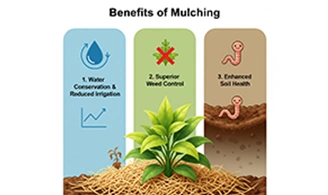
Mulching is more than a cosmetic practice; it is a vital agronomic tool. Below are its major benefits:
1. Enhances Soil Health
- Organic mulches, when decomposed, enrich the soil with organic matter. This improves soil structure, porosity, and aeration, enabling roots to penetrate deeper.
- Mulch provides food and habitat for beneficial soil organisms—bacteria, fungi, and earthworms—which accelerate nutrient cycling and humus formation.
2. Conserves Soil Moisture
- By covering the soil, mulch reduces direct evaporation from sun and wind.
- This means farmers need less irrigation, a crucial advantage in water-scarce regions. Over time, this reduces both water use and irrigation costs.
3. Suppresses Weed Growth
- Mulch cuts off sunlight to weed seeds, hindering germination and growth.
- This lowers the need for herbicides or manual weeding, saving time, money, and labor.
4. Regulates Soil Temperature
- During scorching summers, mulch keeps soil cooler.
- In winter or cooler climates, it retains warmth.
- This insulation effect protects roots from extreme temperature fluctuations, reducing stress on crops.
5. Prevents Soil Erosion
- A mulch layer reduces the impact of raindrops on soil particles and minimizes runoff.
- It also protects against wind erosion, particularly in sandy or dry areas.
6. Supplies Nutrients Gradually
- Organic mulches decompose over time, releasing essential nutrients in a slow and steady manner.
- Compost, straw, and leaf mulch are particularly good for improving long-term soil fertility.
The combined effect of these benefits leads to healthier plants, higher yields, reduced input costs, and greater resilience against climate challenges.
Different Types of Mulches

Mulches can be broadly categorized into organic, inorganic, and living types. Each comes with its unique strengths and limitations.
1. Organic Mulches
These are derived from natural plant or animal matter. They decompose over time, enriching the soil.
- Straw: Lightweight, easy to spread, suppresses weeds, and retains moisture.
- Grass Clippings: Rich in nitrogen, suitable for vegetables and fruit trees. Must be free from herbicides.
- Wood Chips/Bark: Decompose slowly, best for orchards or long-term soil improvement.
- Leaves: Readily available, inexpensive; shredded leaves prevent matting.
- Compost: Highly nutritious, improves both fertility and soil structure.
Pros: Boosts fertility, improves microbial life, usually low-cost.
Cons: Needs periodic replenishment, may attract pests, and can cause nitrogen tie-up if high in carbon.
2. Inorganic Mulches
These are man-made or mineral-based materials that don’t break down easily.
- Plastic Films (black, silver, red, transparent): Widely used in commercial farming to conserve water, suppress weeds, and regulate soil temperature.
- Landscape Fabrics: Porous, durable, and effective in blocking weeds while allowing water penetration.
- Gravel/Stones: Permanent, good for landscaping or xeriscaping, but do not add fertility.
- Rubber Mulch: Made from recycled tires; long-lasting but controversial due to potential chemical leaching.
Pros: Durable, effective in weed and moisture control.
Cons: Do not enrich soil, may overheat the ground, can cause pollution if plastics are not managed properly.
3. Living Mulches
These involve planting cover crops or ground covers that act as a protective living layer.
- Cover Crops: Legumes (clover, alfalfa, vetch) fix nitrogen and improve soil fertility.
- Ground Covers: Plants like creeping thyme or ivy are used in orchards and landscaping.
Pros: Improves biodiversity, protects against erosion, and can regenerate naturally.
Cons: May compete with the main crop for nutrients and water; requires careful management.
Also Read: Types of farming in India – Factors, Techniques & Importance
Where and How Mulching is Applied
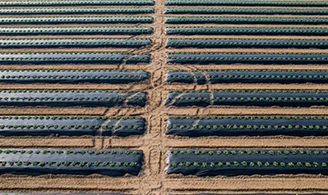
Mulching applications vary depending on crop type, geography, and agricultural goals:
- Field Crops: In cereals, legumes, and cotton, mulching reduces water stress and suppresses weeds. Plastic mulches are often used in commercial row crops.
- Vegetable Farming: Tomatoes, peppers, cucumbers, and root vegetables thrive under mulched soil because of consistent moisture and temperature.
- Orchards and Vineyards: Mulch around trees improves root health, saves water, and reduces competition from weeds.
- Gardens and Landscaping: Bark, gravel, or decorative mulches enhance aesthetics while reducing maintenance.
- Container Gardening: Mulching in pots lowers watering frequency and protects roots from overheating.
- Erosion Control: On slopes and degraded lands, mulching reduces soil loss and supports re-vegetation.
- Urban and Restoration Projects: Mulches are used in parks, green belts, and restoration sites for soil stabilization.
Best Practices for Effective Mulching
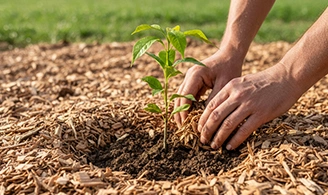
To maximize benefits, mulching must be applied thoughtfully.
1. Choose the Right Mulch
- Match mulch to crop needs (plastic mulch for warm-season crops, straw or compost for vegetables, wood chips for orchards).
- Consider soil drainage, climate, and cost before deciding.
2. Apply at the Correct Depth
- 5–10 cm is ideal for organic mulches. Too thin won’t work; too thick may suffocate plants.
3. Keep Mulch Away from Stems
- Always leave a small gap around trunks and stems to avoid rot and pest infestations.
4. Time the Application
- Apply mulch after soil warms in spring or immediately after planting to conserve moisture.
5. Maintain and Replenish
- Check regularly for decomposition, weed intrusion, or compaction.
- Reapply organic mulches when they thin out.
Read Also: Role Of tractor steering system in agriculture
Challenges and Mistakes to Avoid
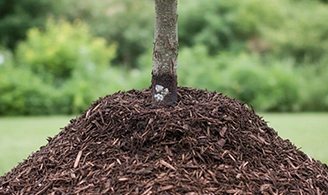
Despite its advantages, mulching can backfire if misused:
- Over-mulching can suffocate roots and block water infiltration.
- Mulch piled against trunks may cause stem rot.
- Plastic mulches without perforations can create waterlogging or overheating.
- Using contaminated mulch (with weed seeds or herbicides) may harm crops.
- Neglecting replenishment reduces long-term benefits.
How Mulching Boosts Yields

Mulching leads to yield improvements through several mechanisms:
- Stable moisture → less stress during dry spells → better growth.
- Insulated soil → uniform germination and strong root development.
- Weed suppression → more resources for the crop.
- Decomposition → steady nutrient supply.
- Better soil structure → deeper root penetration.
- Reduced diseases → healthier foliage and fruits.
Together, these factors create healthier plants, improved harvest quality, and in many cases, higher profitability for farmers.
Case Studies and Real-Life Examples

- Vegetable growers in India using black plastic mulch report 20–30% higher yields in tomatoes and peppers.
- Orchard farmers applying wood chips around apple trees saw reduced irrigation needs and healthier root systems.
- Maize and peanut farmers observed better drought resistance and weed suppression when using straw or plastic mulch in strip cropping.
Sustainability and Mulching
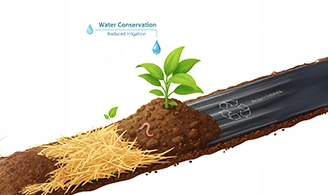
Mulching also contributes to sustainable farming by:
- Reducing water consumption.
- Enhancing soil organic matter and carbon sequestration.
- Lowering reliance on chemical herbicides.
- Supporting biodiversity in soil life.
- Providing resilience against climate variability.
However, the environmental downsides of non-biodegradable plastics should be managed carefully through recycling or adopting biodegradable films.
For more farming insights, visit our blogs section: Mahindra Tractors
Conclusion: A Low-Cost, High-Impact Practice

Mulching is much more than a simple farming trick—it is a multi-functional agricultural practice that supports soil health, conserves water, reduces weeds, moderates climate stress, and boosts yields.
For farmers, the key lies in:
- Choosing the right mulch for their local conditions.
- Applying it at the right depth and time.
- Maintaining it carefully.
As agriculture faces rising input costs, water scarcity, and climate challenges, mulching offers a practical, affordable, and eco-friendly solution for building resilient and profitable farms.










